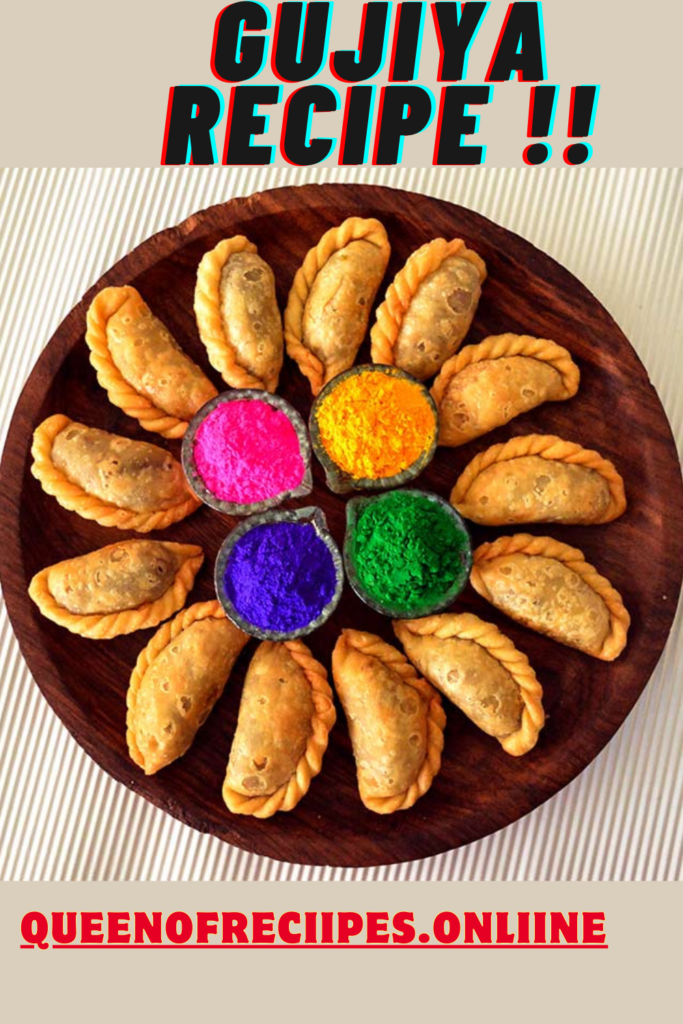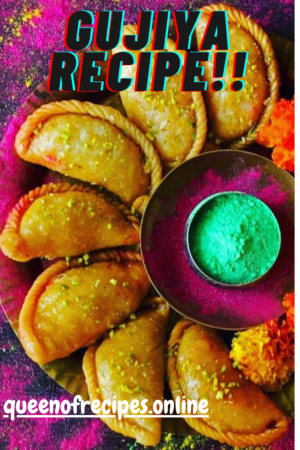Table of Contents
About
Gujiya is a popular Indian sweet pastry that is commonly made during festive occasions such as Holi and Diwali. It is a crescent-shaped pastry that is filled with a delicious mixture of grated coconut, dry fruits, and sweetened khoya (dried milk). The pastry is deep-fried until golden brown and then dusted with powdered sugar for an extra touch of sweetness. It is a traditional and beloved dessert in Indian cuisine, and it is often exchanged as a gift during festivals and celebrations. The crispy exterior and the sweet, nutty filling of gujiya make it a delightful treat that is enjoyed by people of all ages.
Here is the recipe to make Gujiya at home:
Ingredients
For the pastry dough:
- 2 cups all-purpose flour
- 1/4 cup ghee or oil
- A pinch of salt
- Water as needed
For the filling:
- 1 cup grated coconut
- 1/2 cup khoya (dried milk)
- 1/2 cup sugar
- 1/4 cup chopped mixed nuts (almonds, cashews, pistachios, and raisins)
- 1/2 tsp cardamom powder
Other:
- Oil or ghee for deep frying
- Water for sealing the gujiyas
- Powdered sugar for dusting
Directions:
- In a mixing bowl, combine the flour, ghee, and salt. Mix well until the mixture resembles breadcrumbs.
- Add water slowly to the mixture, and knead until you have a smooth and pliable dough. Cover the dough with a damp cloth and let it rest for 30 minutes.
- In a separate pan, heat the grated coconut on medium heat for a few minutes until it turns slightly brown. Add the khoya, sugar, chopped nuts, and cardamom powder to the pan, and stir well. Cook for 2-3 minutes until the mixture thickens and turns into a sticky and cohesive filling. Let it cool.
- Roll out the dough into small circles of 3-4 inches in diameter. Place a tablespoon of the filling in the center of each circle.
- Dip your finger in water and run it along the edge of the dough circle. Fold the circle in half and press the edges firmly to seal the gujiya. Use a fork to make a pattern along the edges for a decorative touch.
- Heat oil or ghee in a deep pan on medium heat. Once the oil is hot, gently drop the gujiyas into the oil and fry until they turn golden brown. Drain them on a paper towel to remove excess oil.
- Dust them with powdered sugar and let them cool before serving.
Note: Gujiyas can be stored in an airtight container for up to a week. Reheat them in a microwave or oven before serving.


Nutritional value for Gujiya
Gujiya is a delicious sweet pastry that is high in calories, sugar, and fat. While it is a tasty indulgence, it should be enjoyed in moderation as part of a balanced diet. Here is the approximate nutritional value for one serving:
- Calories: 300-350 calories
- Fat: 20-25 grams
- Carbohydrates: 30-35 grams
- Protein: 3-4 grams
The exact nutritional value may vary depending on the specific ingredients used in the recipe. The filling of Gujiya contains coconut, khoya, and mixed nuts, which are all high in fat and calories. The pastry is also deep-fried, which adds extra calories and fat. However, it does offer some nutritional benefits as well. The nuts and coconut used in the filling provide healthy fats and some protein.
If you are trying to maintain a healthy diet, it is best to enjoy Gujiya in moderation and balance it with other nutrient-dense foods. You can also make some modifications to the recipe to reduce the calorie and fat content, such as using whole wheat flour instead of all-purpose flour, reducing the amount of sugar used in the filling, and baking the Gujiya instead of deep-frying them
Tips and Tricks
Gujiya is a popular Indian sweet pastry filled with a sweet mixture of khoya (milk solids), nuts, and spices. Here are some tips and tricks to help you make delicious Gujiya:
- Dough preparation: Prepare a smooth and pliable dough by kneading all-purpose flour (maida) with ghee (clarified butter) and a pinch of salt. Rest the dough for at least 30 minutes to allow it to become more elastic and easier to roll.
- Filling flavors and texture: To make the filling, roast khoya until it turns light brown and add a mixture of finely chopped nuts like almonds, pistachios, and cashews. Add cardamom powder, saffron strands, and a touch of sweetness with powdered sugar or jaggery. This combination of flavors and textures enhances the taste of the Gujiya.
- Proper sealing: When shaping, ensure that the filling is evenly distributed and that the edges are sealed tightly. Use water or a flour-water paste to moisten the edges and press them firmly together to prevent the filling from leaking during frying.
- Fry on low to medium heat: Heat oil or ghee in a deep pan or kadai for frying the Gujiyas. Fry them on low to medium heat to ensure that the pastry cooks evenly and becomes crispy and golden brown. Frying on high heat may result in undercooked or burnt Gujiyas.
- Drain excess oil: After frying, place them on a paper towel or a wire rack to remove any excess oil. This helps keep them light and prevents them from becoming overly greasy.
- Optional baking: If you prefer a healthier alternative to frying, you can also bake the Gujiyas in a preheated oven at around 350°F (175°C) until they turn golden brown. Brush them with a little melted ghee before baking to add a touch of richness.
- Serve at room temperature: Allow them to cool completely before serving. They are typically enjoyed at room temperature, although they can be refrigerated for a short time to firm up before serving.
- Storage and shelf life: It can be stored in an airtight container at room temperature for several days. However, their texture may become softer over time. If you want to extend their shelf life, refrigerate them, but allow them to come to room temperature before serving.
Remember, making Gujiya requires patience and practice to perfect the shape and achieve the desired taste. Enjoy the process and savor the delightful flavors of this traditional Indian sweet.
Health Benefits
While Gujiya is a delicious and indulgent sweet treat, it is important to note that it is typically high in calories, sugar, and saturated fat. Therefore, its health benefits may be limited. However, here are a few potential aspects to consider:
- Nutrient-rich filling: Its fillings often contain ingredients like nuts, which provide essential nutrients such as healthy fats, protein, and vitamins. These nutrients can offer some health benefits when consumed in moderation.
- Source of energy: It is a calorie-dense sweet due to its ingredients like khoya (milk solids), ghee, and sugar. While excessive calorie intake can be detrimental, consuming Gujiya in moderation can provide a quick source of energy.
- Cultural and emotional well-being: It is often associated with festive occasions and celebrations. Enjoying traditional foods can contribute to cultural and emotional well-being, fostering a sense of connection and joy.
It’s important to consume it in moderation and be mindful of portion sizes. People with specific dietary restrictions or conditions like diabetes should exercise caution or consult with a healthcare professional regarding their intake. Incorporating a balanced and varied diet, along with regular exercise, is essential for overall health and well-being.
Serving Suggestions
- Powdered Sugar: Dust the Gujiya with powdered sugar for a classic and simple touch. It adds a sweet and delightful flavor to the sweet pastry.
- Chopped Nuts: Garnish the Gujiya with a sprinkle of chopped nuts like almonds, cashews, or pistachios. The nutty crunch complements the sweet filling.
- Flavored Sugar Syrup: Dip the Gujiya in flavored sugar syrup, such as rose syrup or saffron-infused syrup, for an extra burst of sweetness and aroma.
- Rose Water: Drizzle a few drops of rose water over the Gujiya for a fragrant and floral touch.
- Saffron Milk: Serve the Gujiya with a side of saffron-infused milk for a luxurious and rich pairing.
- Fruit Compote: Pair Gujiya with a fruit compote made from berries, mangoes, or apples for a fruity and tangy contrast.
- Cardamom Powder: Sprinkle a pinch of ground cardamom over the Gujiya for a warm and aromatic flavor.
- Silver Varak: Place a small piece of edible silver varak on top of each Gujiya for an elegant and traditional presentation.
- Accompany with Chai: Enjoy Gujiya with a cup of Indian chai (tea) for a perfect tea-time snack.
- Ice Cream: Serve warm Gujiya with a scoop of vanilla or saffron ice cream for a delightful fusion dessert.
Gujiya is a delicious and festive Indian sweet, commonly prepared during festivals like Holi and Diwali. These serving suggestions enhance the flavors and presentation of this delightful pastry, making it an irresistible treat for any occasion.
FAQs
Can I make Gujiya without using khoya?
Yes, you can make Gujiya without using khoya. A common alternative for khoya is using a combination of milk powder, condensed milk, and nuts. Mix milk powder, condensed milk, and finely chopped or ground nuts to create a sweet and rich filling. Adjust the sweetness and consistency to your preference. This alternative filling provides a similar creamy and nutty flavor to traditional khoya-based Gujiya.
Can I make Gujiya with different fillings, such as chocolate or fruit?
Yes, you can certainly experiment with different fillings for Gujiya. For a chocolate filling, you can use a combination of melted chocolate, cocoa powder, and nuts. Ensure the filling is not too runny to prevent leakage during frying. For a fruit filling, you can use cooked and sweetened fruit compote or jam. Make sure the fruit filling is well-drained to avoid excess moisture. Get creative and enjoy exploring different flavors and combinations for your Gujiya fillings
Can I make Gujiya with a reduced amount of sugar or healthier ingredients?
Yes, you can make Gujiya with a reduced amount of sugar or opt for healthier ingredients. To reduce sugar, you can use natural sweeteners like dates or jaggery, which provide a richer flavor. Additionally, you can incorporate healthier ingredients like whole wheat flour or a combination of whole wheat and all-purpose flour to increase the fiber content. Choosing healthier fats like ghee or coconut oil in moderation can also be beneficial. These modifications can make Gujiya a slightly healthier option without compromising on taste.
How long can Gujiya be stored, and what is the best way to store them?
Gujiya can be stored for about 1 to 2 weeks if stored properly. The best way to store Gujiya is to place them in an airtight container or a zip-top bag. Store them at room temperature in a cool and dry place, away from direct sunlight and moisture. It is advisable to separate layers of Gujiya with parchment or wax paper to prevent them from sticking together.

